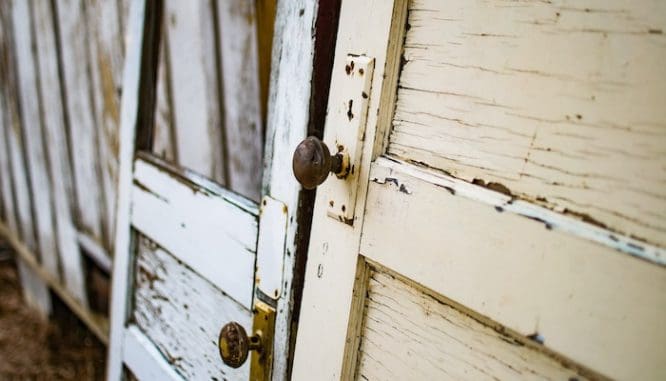Good Bones or Money Pit? How to Buy the Right Older Home for You
- Published on
- 5 min read
-
 Dena Landon Contributing AuthorClose
Dena Landon Contributing AuthorClose Dena Landon Contributing Author
Dena Landon Contributing AuthorDena Landon is a writer with over 10 years of experience and has had bylines appear in The Washington Post, Salon, Good Housekeeping and more. A homeowner and real estate investor herself, Dena's bought and sold four homes, worked in property management for other investors, and has written over 200 articles on real estate.
Historic homes appeal to homebuyers who dream of living in a unique home. But if you turn that dream into a reality without knowing what you’re getting into, you could find yourself living in a nightmare. Common problems in older homes result from deferred maintenance, poorly executed repairs, and older building materials, and fixing them can be expensive.
The issues found in an older house will depend on how well previous owners have maintained it, but you will find unpreventable age-related problems. If your heart is set on living in one of these charming residences, here’s what you’ll need to know about spotting good old bones.
Foundation issues
Due to the movement of the dirt around them, foundations settle over time. Settling leads to cracks, moisture, or water in the basement, and uneven floors in the living areas. Foundation issues carry up into every other part of the house, from doors to windows to the roof.
Warning signs of foundation problems include:
- Uneven floors
- Cracks in interior walls, especially where they meet the ceiling or over doorways
- Cracks and crumbling in the foundation walls
- Windowsills that jam and windows that are hard to open
- Water spots and signs of moisture in the basement
Mark Abel, an agent with 14 years of experience in Apple Valley, Minnesota, an area with older housing stock, says that it’s common to find “limestone or block foundation that has settled over a hundred years, and it’s pretty typical to have severe bowing in a wall or big, horizontal cracks,” in older homes.
It’s not possible to replace an entire foundation, as your house rests on it, but foundation repairs run between $2,300 to $6,800.

Roof
A poorly maintained roof will lead to water damage inside the home and to your personal property, plus poor energy efficiency.
Robert Andrews, a Medina, Ohio based agent who’s sold 67% more homes than his peers, advises looking for water spots on exterior walls and closely examining the flashing around the chimney and eaves. “The first thing I want to have my eyes on when walking up to a house is the roof,” he says. Other signs of an older roof include cracked shingles or warped and missing tiles. In the attic, look for moisture and stains on the sheeting and planking.
If water has been getting in, you care about whether the water damage was past or current. If past, request proof from the seller that they made repairs. If current, it will need to be fixed immediately. Homebuyers using government financing, such as an FHA loan, might be unable to get a mortgage on a house with a current roof leak. Replacing a roof costs between $5,300 to $11,000.
Plumbing
Whether it’s due to original plumbing, pipe movement, or deteriorated fixtures, problems such as leaks, clogs, and stoppages can be smelly and nasty until they’re fixed.
Look for the following:
- Galvanized pipes in homes built prior to the 1960s
- Polybutylene pipes in homes built between the 1970s to the 1990s
- Original valves and washers, which can leak and cause nasty smells
- Clogged bathroom, sink, and floor drains
Older galvanized pipes cause discolored water, weak water pressure, and poor water quality. Polybutylene pipes, which are now against building codes, react poorly to oxidants in the water, break down, and can lead to an entire plumbing system failure. Have your home inspector check if the pipes have been updated; if not, you could have to replace the home’s entire plumbing system.
It can cost an average of $2,500 to $15,000 to replace all of a home’s plumbing. Replacing sections of pipe runs between $350 to $1,800, and the cost will be influenced by how difficult it is to access the pipes and the materials you select for replacements.

Sewer lines
The old-growth trees in a neighborhood may have been part of its appeal, but roots and branches can wreak havoc with sewer lines. Tiny offshoots crawl into openings in the pipes, then expand and grow inside them. This growth causes clogs, backups, and possible flooding in your basement.
Fixing this problem can be as simple as flushing chemicals through the pipes to kill them, or as complicated as excavating and replacing a damaged pipe. In that case, you would also have to re-landscape so the tree doesn’t interfere with your solution.
Pipes made from older materials disintegrate and collapse, and replacing the main sewer line could cost between $2,250 to $5,750. Replacing the full sewer system is much more costly, at $8,000 to $30,000.
To find clogs or collapsed sewer lines, hire a plumber to perform a sewer inspection. They’ll send a snake with a small video camera attached through the sewer’s clean-out. Sewer inspections start at $200 and up, and are worth it given the expense of any future surprises.
Electrical
Original wiring, such as knob-and-pull, will no longer be up to code. If repairs or replacements were made incorrectly, or the wiring hasn’t been maintained, it could lead to an electrical fire.
Knob-and-tube wiring is found in homes built before 1950 and up until the 1960s. According to Andrews, “if the integrity of it was respected and not violated, it can be pretty safe. But whenever there’s knob-and-tube, it has to have a licensed electrician look at it.” If you’re considering buying a home with this wiring, hire an electrician in addition to your home inspector.
Re-wiring an entire house can cost between $2,000 and $9,000, depending on square footage. If you need an electrician for smaller fixes, their hourly rate ranges from $40 to $100 plus a service fee for the visit and materials.

Asbestos, lead, and other hazardous materials
As building materials have evolved over the decades, scientists have discovered that materials once thought safe were hazardous. However, they could still be present in older homes. Here are hazardous materials you could find in an older home:
- Asbestos, used as insulation in walls, floor tiles, and to wrap boilers between the 1930s to the 1970s
- Lead-based paint, used in homes built before 1978
- VOC, or volatile organic compounds
- Radon
- Mold or mildew
According to the EPA, exposure to asbestos increases your risk of lung disease and can lead to several types of cancer. To remove asbestos, you’ll need to hire a professional, certified remediation company. The cost ranges from $1,000 to $2,700 if you only need the furnace insulation or floor tiles removed, up to $15,000 to $30,000 for an entire house.
Deteriorated or chipped lead-based paint can cause serious health hazards. Federal law requires owners of older homes to disclose the presence of any lead-based paint in the home. Homeowners can either claim they have no knowledge or provide a remediation certificate if they’ve had the house deleaded. Deleading a home can cost an average of $8 to $17 a square foot.
Many remodeling activities generate VOC, or volatile organic compounds. If previous homeowners used furniture strippers, paints and thinners, glues and adhesives, or wood finishes in your home, these toxins could be present and cause eye, ear, and nose irritations plus other more serious health concerns. You can hire an expert to test your air quality or buy an at-home kit and buy air purifiers to improve air quality.
Radon is a radioactive gas produced by elements decaying in soil and rock. High levels can be fatal and are most often found in homes with dirt and stone foundations. If your home tests positive for radon, you might need to seal the foundation walls, install ventilation, or finish the basement. The cost of radon remediation starts between $780 to $1,200 or higher if you need to install ventilation.
Mold or mildew grows when a home becomes damp or wet. Bleach kills mold, but dead spores can still be harmful. When breathed in, it leads to asthma and allergies, infections, irritated skin, and in extreme cases, organ damage and cancer. The average cost of remediation is $2,200.
Pests
Older homes sometimes have unwanted visitors like carpenter ants, termites, mice and rats, and powderpost beetles. If previous owners didn’t address pest infestations, they could have done serious damage to your home’s structure.
Andrews has seen entire plate sills, a part of the foundation that serves as a base for a floor joint frame, eaten by termites. Mice chew on wood, and carpenter ants dig into wood to build their nests; both pests cause structural damage.
If you’re concerned, you do have the option to request a pest inspection before the closing. In addition to hiring an exterminator to remove pests, there will be ongoing monitoring and prevention costs to keep them out. The costs swing between as little as $100 for ants to $2,500 for termite exterminators.
HVAC
Homes built in the early part of the 1900s or before might have radiators tucked in every corner. There won’t be ductwork in the walls, and walls will probably be too thin to add ducts. To cool your home during the summer, you’d have to invest in window or ductless air conditioning units.
Older HVAC systems cost more to run, maintain, and service. They’re less energy-efficient, and you should expect hefty heat bills in the winter if you live in a cold climate.

Old windows and doors
Old windows and doors contribute to poor energy-efficiency. Wood expands and contracts throughout the seasons, and over the years this leads to poorly fitted windows and doors. Heat escapes through single-pane glass, under gaps between doors and the floor, and cold air and possibly water takes its place.
The cost of replacing all the windows in a house varies considerably. Many older homes have custom-sized windows, as window sizes weren’t standard back in the day. As well, the home could have more windows than a new build.
It isn’t difficult to replace doors or add weather stripping for a quick but temporary fix. Again, the cost to replace all the house’s doors will depend upon the number of doors to replace and their sizes.
If you have your heart set on living in a 100-year-old home, the good news is that all the common problems in older homes can be worked with or fixed. The deciding factor will be how much money you have available to fix them and your willingness to invest that money in the property.
Header image source: (Josh Appel / Unsplash)
